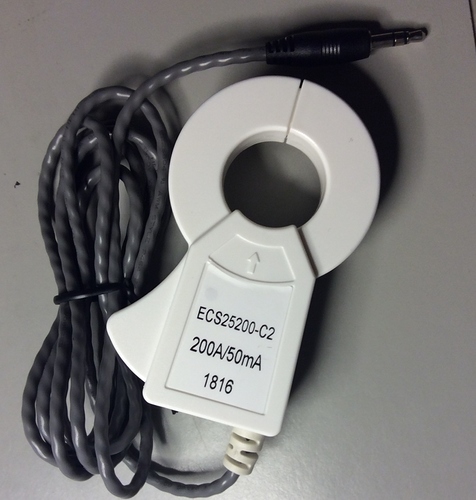Well, here’s what I’ve got. I shorted the leads of the old CT, and put a 50A ECOL09 on it with the CT lead looped 4 times through the ECOL09 (all with the power off, natch, I’m a chicken).
I have two graphs - one for the loads, and one for the measurement of the CT. No real reason for that, other than I have two IOTAWatts and I hooked the 240V loads up to the first one and the 120V loads up to the second, which is where I stole the ECOL09 from. A whole bunch of extraneous low-power circuits were excluded, because they just made things difficult to read. Iotawatt_a.png shows the loads, and iotawatt_b.png shows the power measurement from the ECOL09 of the old CT around the mains.
So, what I see is:
at around 12:41, there’s a 7550 watt step up in load (green trace, the EV charger), and about 5 minutes later a step down.
Between 12:54 and 13:06, the EV charger cycles between 320 and 1000 watts a number of times.
At about 13:04, the water heater (blue trace) kicks on for about 2 minutes at 4600 watts.
At about 13:17, the A/C and air handler kick down to low speed. A/C drops from about 4550 to about 3380 Watts, and the air handler from about 450 to 165 watts.
On the CT measurement side, we see about a 73W jump corresponding to the 7550W EV Charger turn-on, and about the same on turn-off.
We see about 7W jumps corresponding to the 680W jumps of the EV charger from 12:54 to 13:06.
We see about a 46W jump corresponding to the 4600W Water Heater.
We see about a 15W drop corresponding with the 1450W drop from the A/C dropping to low.
To the casual eye, that might suggest the ECOL09 is measuring about (1/100 / 4 turns through the ECOL09)=1/400th the power drawn by the loads. The ECOL09 is NOT configured with “Double” in the input configuration dialog, so we should probably double (halve?) this estimate to 1/200th the power. Does this suggest that the old CT’s have a 200:1 turns ratio, and I should expect 1A output for a 200A mains current?
Let’s go back to the 0.5 ohm, 5W resistor in the old device. 1A through it would dissipate about 0.5W (from P=I2R) - but there were two CT’s hooked up to the resistor in parallel, suggesting a 1W max power dissipation. A 5W resistor would be a conservative and reasonable choice.
Anyway, any thoughts you have would be interesting to me. I’ve got both IOTAWatts installed, and they’re working great although I don’t have the mains monitored yet or the data getting saved anywhere.





